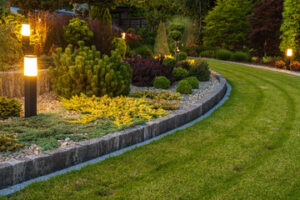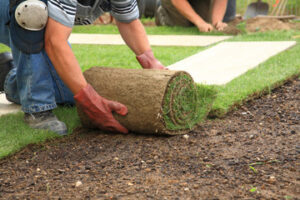Landscape lighting enhances the beauty and functionality of outdoor spaces by providing illumination that transforms the ambiance and increases safety. Proper lighting not only highlights the architectural features of a property but also creates a warm and inviting atmosphere.

The strategic placement of lights around gardens, walkways, patios, and other outdoor areas elevates the overall aesthetic while adding practicality to the space. As outdoor living becomes more popular, landscape lighting has gained recognition for its ability to extend the usability of outdoor spaces well into the night while improving security and adding a sense of elegance. Contact Elegant Custom Images Inc for professional help.
The primary benefit of landscape lighting is the enhancement of the visual appeal of a property. When properly designed and installed, lighting can accentuate the natural beauty of the landscape, drawing attention to trees, shrubs, and flower beds. Soft lighting around pathways and garden beds creates depth and texture, making the space feel more dynamic and inviting. Uplighting techniques, where lights are directed upward at trees or architectural elements, create dramatic shadows and highlight the height and structure of the landscape. Downlighting, where lights are positioned high and directed downward, creates a moonlight effect that mimics natural lighting conditions, producing a serene and calming atmosphere. The combination of different lighting techniques allows for creative expression while maintaining a balanced and harmonious look.
Safety and security are also major advantages of landscape lighting. Illuminated pathways and driveways reduce the risk of tripping and falling, ensuring that guests and residents can navigate the property safely at night. Motion-activated lights provide added security by deterring potential intruders and alerting homeowners to movement around the property. Well-lit entryways and staircases improve visibility, making it easier to access and move around the property after dark. Proper lighting placement also helps to identify property boundaries, guiding guests through designated walkways and preventing accidental damage to landscaping. The psychological effect of a well-lit property also creates a sense of comfort and security, enhancing the overall living experience.
Energy efficiency is a growing consideration in landscape lighting design. Advances in lighting technology have led to the development of low-voltage and LED lighting options that provide powerful illumination while consuming minimal energy. LED lights are known for their long lifespan and durability, making them a cost-effective solution for outdoor lighting. Solar-powered lights offer an environmentally friendly option, using renewable energy to provide consistent lighting without the need for electrical wiring. Smart lighting systems with timers and motion sensors further reduce energy consumption by ensuring that lights are only used when needed. These energy-efficient options allow homeowners to enjoy the benefits of landscape lighting without the worry of high utility costs.
Landscape lighting also enhances the functionality of outdoor living spaces. Patios, decks, and garden seating areas become more accessible and comfortable when illuminated with soft, ambient lighting. Dining and entertaining outdoors becomes more enjoyable when the space is properly lit, allowing guests to relax and appreciate the surroundings. Task lighting around outdoor kitchens and grilling areas improves visibility and safety while preparing food. Accent lighting on water features, sculptures, and garden art adds character and creates focal points within the landscape. The ability to control lighting intensity and color allows homeowners to create different moods and atmospheres depending on the occasion, making the outdoor space adaptable for various activities and events.
The process of designing and installing landscape lighting requires careful planning and attention to detail. The first step involves assessing the layout of the outdoor space and identifying key features to highlight. Trees, shrubs, flower beds, architectural elements, and water features are common focal points for lighting. The type of lighting fixture and the angle of illumination play a crucial role in achieving the desired effect. For example, spotlighting can create dramatic shadows and highlights, while path lights provide soft, even illumination along walkways. The color temperature of the light also affects the overall ambiance; warm white light creates a cozy and inviting atmosphere, while cooler tones produce a more modern and crisp look. The placement of fixtures should balance functionality and aesthetics, ensuring that the lighting enhances the space without creating glare or harsh shadows.
Professional installation of landscape lighting ensures that the system operates efficiently and safely. Electrical wiring and connections must be weatherproof and properly grounded to prevent damage and ensure longevity. Low-voltage systems are commonly used for landscape lighting because they are safer and more energy-efficient than traditional high-voltage systems. Transformers regulate the voltage and distribute power to the lighting fixtures, ensuring consistent illumination. Timers and smart controllers allow for automated operation, adjusting the lighting schedule based on the time of day and seasonal changes. This level of automation enhances convenience while reducing energy consumption.
Maintenance is essential to keep landscape lighting functioning at its best. Over time, fixtures may accumulate dirt, debris, and moisture, affecting their performance and appearance. Regular cleaning and inspection of fixtures, bulbs, and wiring help to prevent issues and ensure that the lighting system remains reliable. Replacing burned-out bulbs and adjusting fixture positioning ensures that the lighting continues to highlight the intended features and maintain the desired ambiance. Trimming overgrown plants and trees prevents shadows and obstructions that can diminish the effectiveness of the lighting. Periodic upgrades to LED technology and smart controls improve efficiency and extend the lifespan of the system, providing long-term value.
The versatility of landscape lighting allows homeowners to customize the look and feel of their outdoor space. String lights, lanterns, and decorative sconces add a touch of personality and charm to garden seating areas and pergolas. Water-resistant fixtures designed for pools and fountains create captivating reflections and movement. In-ground lighting along walkways and driveways provides a sleek and modern look while improving visibility. Color-changing lights and programmable controllers allow for dynamic lighting effects that can be adjusted to match seasonal themes, holidays, and special events. This level of customization allows homeowners to create a unique and personalized outdoor environment that reflects their style and enhances the overall character of the property.
The psychological benefits of landscape lighting should not be overlooked. Spending time in a well-lit outdoor environment promotes relaxation and reduces stress. The calming effect of soft, ambient lighting encourages mindfulness and connection with nature. Evening gatherings with friends and family become more enjoyable when the outdoor space is warm and inviting. The visual continuity created by consistent lighting around the property enhances the overall sense of harmony and balance, creating a sanctuary where individuals can unwind and recharge. The ability to adjust lighting levels and colors provides a sense of control over the environment, allowing homeowners to tailor the space to suit their mood and preferences.
As outdoor living continues to grow in popularity, landscape lighting remains an essential element of property design and maintenance. The combination of aesthetic appeal, safety, and functionality makes it a worthwhile investment for homeowners seeking to maximize the potential of their outdoor spaces. Advances in lighting technology and smart controls provide greater flexibility and efficiency, allowing for creative and sustainable design solutions. A well-lit landscape not only enhances the beauty of a property but also improves the quality of life for those who inhabit and enjoy the space. The transformative power of light extends beyond visual impact, creating an atmosphere of comfort, security, and relaxation that elevates the overall living experience.
